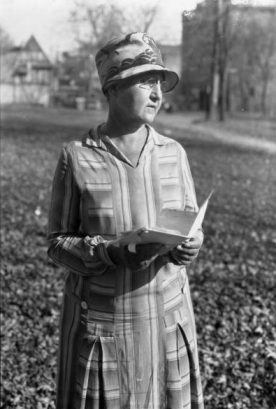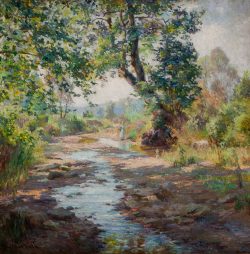Lucie Hartrath, from a photograph by Frank Hohenberger, circa 1927–1928, Frank M. Hohenberger Photograph Collection. Courtesy, The Lilly Library, Indiana University, Bloomington, Indiana.

Lucie Hartrath 1867–1962
A native of Boston, Lucie Hartrath spent her youth in Cleveland, with extended stays in Zurich, Switzerland, where she received her first art instruction, and in Paris. Hartrath returned to Paris in 1891 to study for three years at the Académie Colarossi. She then attended the Art Institute of Chicago, working under John Vanderpoel. In 1898, Hartrath resumed her studies in Paris, where her teachers included Raphael Collin and André Rixens. In 1901 alone, she was represented in exhibitions in Düsseldorf, Cologne, and Berlin, Germany, as well as in the prestigious Paris Salon. In 1902 Hartrath was appointed head of painting and drawing instruction at Rockford College, resigning two years later for further training at the Art Institute. She was in Munich in 1906 and in 1907, studying with Angelo von Jank.
By the time she established a studio in Chicago’s Tree Studios building in 1908, Hartrath had been exhibiting in the Art Institute’s various annual exhibitions for more than a decade. Until the early 1940s she showed her work prolifically and she participated in many local artists’ organizations. Although based in Chicago, she was also represented in regional and national venues, including the Pennsylvania Academy of the Fine Arts in Philadelphia, the Society of Western Artists, the Cincinnati Art Museum, and the 1915 Panama-Pacific International Exposition in San Francisco. In the 1920s, Hartrath took advantage of expanded opportunities to reach middle-class consumers with shows at department stores, commercial art galleries, and women’s clubs as well as such organizations as the Chicago Galleries Association, a cooperative gallery, and the annual Hoosier Salon for artists working in Indiana, held in Chicago at the Marshall Field and Company department store. Hartrath won fourteen awards at the Hoosier Salon between its 1925 inaugural show and the 1940 exhibition, as well as several important prizes in the Art Institute’s annual shows. She was in demand as an exhibition jurist and lecturer.
Although she executed figural works, Hartrath’s reputation always rested on her work in landscape, in which she was self-taught. She made her first visit to Indiana’s Brown County sometime between 1908 and 1910, and she encouraged other Chicago artists, such as Charles Dahlgreen, to join the Hoosier and Chicago painters who had recently discovered the region’s rural charms. A pillar of the Brown County artists’ colony, Hartrath forged close friendships with many of its members, including L. O. Griffith, and she helped found the Brown County Art Association in 1926. During the 1910s and 1920s in particular, Hartrath’s pleasing impressionist images of country villages and idyllic summer and autumn scenery, often bathed in sunlight and humanized by the unobtrusive presence of a figure, found favor with private collectors, clubs, public schools and libraries, and such civic bodies as the Municipal Art League of Chicago.
Wendy Greenhouse, PhD
